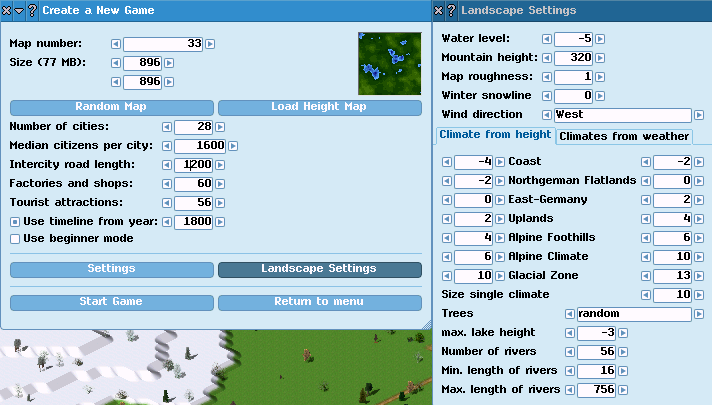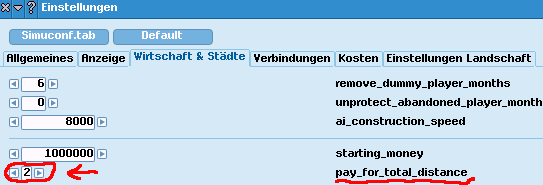Tips for Gameplay
Starting a new map
The desired map must support the required heights which depends more or less on the selected map, map-size and sea level. But you can lend with the landscape settings (see below).
Regions instead Climate Zones
The following comparison provides information about the climate zone scheme of the Pakset.:
| English label | PAK128.german |
|---|---|
| desert climate | Coast |
| tropical climate | North-german plain |
| Mediterranean climate | East Germany |
| temperate climate | Central-german Uplands |
| tundra | Alpine Foothills |
| rocky | Alpine Climate |
| Not shown: | |
| arctic climate - Glacial zone | |
Proper Landscapessettings:
We advise two height-level per climate zone (for the coast is one enough) so that homogeneous cities with appropriate buildings and factories can arise. The Alpine foothills and - zones should include three levels.The value mountainousness should be low (best 0, max. 2). Otherwise, Simutrans might not find a place for the partly very extensive factories and sights. From Simutrans 120.x on flatter maps can also be used if the areas are assigned to other climate zones (regions). This is made possible by the terrain building tool.
Recommend Settings for Landscapes generation

The results also depend on the selected card and the size of the card.
Import older saves
The set has changed a lot. In our experience, old scores are still usable and crashes seem to be rare exceptions. On the safe side is who keeps the old package version (renaming a folder before installing 1.0 is enough).
But even if your game has started without complaint, Simutrans may report missing objects. Even more dangerous if you don't get any feedback and think everything is okay because probably one or the other factory requires a raw material or the newly introduced packaging material without the production stops, which you may not notice until several months later.
If several objects are missing, all you can do is find them based on the one you have last saved the map with and replace them with the new versions.
Which vehicles do I choose for a route?
One should always start from the type of goods. Choose a cheap, modern car that is available at this time. Since version 120.4.1 you can sort the depot according to cost / unit. Here in the vehicle database you can also sort vehicles according to "rcost% e". That is the percentage of the costs of the possible revenue. A car found this way may have a low top speed. For freight trains, for example, this will often only be 65 km / h or 90 km / h. Now you can choose a suitable locomotive to match the speed and train length. Using express locomotives in front of freight trains is usually not economically viable. With buses in city traffic you should note that there is a speed limit of 50 km / h in the city. Faster buses are then unnecessarily expensive.
For train formation, you can orientate yourself on the reality at the Bundesbahn:
The railway has used inexpensive vehicles on less frequented branch lines. These were steam railcars, rail buses, V100 with Silberlinge and BR 628.
In local transport with many passengers, the Berlin S-Bahn, double-decker coaches or ET420.
In contrast, prototypes, luxury trains and high-speed trains are normally expensive. The economical operation of Rheingold, Schienenzeppelin, TEE VT11.5, BR103 with InterCity (dining car), ET403, ICE is challenging.
As a rough guide:
Local traffic needs a utilization of 30% in both directions in order to run economically.
Express trains need a utilization of 50% in both directions.
Luxury trains, prototypes, test railcars and technical pioneering efforts need up to 100% utilization.
Important: There is no Speedbonus in Pak128.german.
The top speed of the vehicle doesn't play a big role. There is no bonus and, above all, no discounts.
A train with the Adler can also run at a profit in the year 2000, of course with the right carriages.
Choosing the fastest vehicle available usually doesn't make sense. Because they are commonly expensive prototypes.
How do I use the signals?
There are normal signals and signals with special functions.
Use special signals only if you really need them and you have understood their function.
Tip for beginners: If your trains just don't want to run or suddenly stop.
Do not try to get your single track network up and running.
Expand it to double track. That doesn't cost much more and is much easier.
- Use each track only for one direction.
- Use only normal signals and these only for one direction.
- Also use platforms only in one direction.
- Pay attention when creating the timetable: Put the stop on the platform with the right direction.
Here is an example map for using of signals
The map contains, from top to bottom:
- A one-track with several stops for one train. Here are no more allowed, or you get a deadlock.
Deadlock means: two trains face each other and wait for the other to clear the way. But neither of the two trains can run because the other is in the way. - A one-track with several stops for 3 trains and passing loops. Three Trains and no more, or a deadlock can happen.
- A one-track with several stops for 9 trains without a signal. Using stations with two platforms.
- End station with choose signals and waiting area. Use of long block signals, to prevent a deadlock on the single-track with several stops. 13 trains possible.
- A simple double-track line with several stops for 14 or more trains.
You can send more trains on the line and see if a deadlock occurs.
Single track with passing points more than 3 trains?
I have a single-track line with single-track stations, like point 2 in the example above. I have several passing points, can I then also drive more than 3 trains?
No, the smallest passing point determines how many trains can run on the whole route. If the passing point can accommodate two trains (train 1 and 2), then a maximum of one train may stand on one side of the passing point (train 3). The (train 4) leads to deadlock. Without manual intervention, traffic break down here.

One possibility is to increase the capacity of the passing loop. For example, subdivide longer sidings with signals. So that several trains can wait one after the other.
By inserting two signals, the capacity was increased to 4 trains, two trains can now wait in each direction. This means that a total of 5 trains can now run. You have to do this for all passing loops. Remember: The smallest passing loop define the numbers of trains, on the the whole railway line.

Another option is to block the single-track sections of the route with long-block signals on both sides so that only one train can travel on the single-track section. This corresponds to point 4 in the example above. But be careful, this is not without its pitfalls and the waiting capacity must be provided on the two-track area in front of and behind.
How far does the long block signal extend?
The track is reserved until the next real signal.

When the path to the passing loop waiting area is free, the long block signal turns green.
Red the long block signal on the left.
Green the long block signal on the right.
Only one vehicle should be moving in the single-track area.
Two lane roads?
At the start of the game and during normal city growth, two-lane roads have been built since version 1.2. These could be boulevards or highways. Unfortunately, these streets are a bit random and are not planned by any city planner. In addition, if there are to be motorways, some reworking is necessary. The cross connections that Simutrans automatically builds must be deleted again and the traffic signs set up accordingly. For me, two-lane trams were the reason to change the configuration file cityrules.tab so that two-lane streets are created. I no longer wanted to tear down rows and rows of houses and weaken the city. Other players start with very small cities and specify the road grid and the two-lane traffic routes from the start. Each player has a different approach.
Since the highways are a matter of taste, some like them, others don't. There are two versions of the cityrules.tab in the config folder.
cityrules_VS1.2_mit_Autobahn.tab
cityrules_VS1.2_ohne_Autobahn.tab
As the name suggests: with(mit) or without(ohne) highways. By renaming or copying to cityrules.tab you can choose whether two-lane roads are to be built.
Urban growth?
Pancakes or high-rise desert?
In the "cityrules.tab" file in the "config" folder there is a parameter "renovation_percentage = 4"
"renovation_percentage = 1" and the cities diverge like pancakes,
"renovation_percentage = 10" the houses rise in level quite quickly and become high-rise buildings.
The value can also be changed in the GUI under the settings in the toolbox. It is important to save and reload the game after the change.
Driving detours to earn additional money?
You can open public transport to a city with a single line, that leads in circle or even in snake lines through the city. This is much more profitable than a star-shaped development or even direct connections between the metropolitan centers. SIM passengers do not complain that they get a extensive sightseeing tour thru the city, on their daily way to work and have to pay extra for it. Even the ICE of Deutsche Bahn goes from Munich to Berlin over Stuttgart, Frankfurt and Hannover. Instead the short way over Landshut, Regensburg, Hof and Leipzig. (Only since the new built fast railway about Erfurt, this is no longer the case.) Of course, you have to pay for railway kilometers and these are a few more than the shortest distance between.
If you find that unreasonable:
You can set in config/simuconf.tab the parameter pay_for_total_distance = 2.

Then the SIM passengers pay for the air line between the start and destination and get the city tour for free from you.
So if you drive detours then these are your costs. But beware, only about 10% detours are included in the calculation of the fares. If you drive more detours then the line will no more profitable. This makes Pak128.German significantly more difficulty.